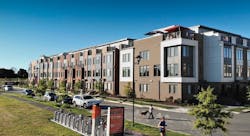Let’s Get Small
EYA's Westside at Shady Grove Metro, in Rockville, Md., offers an attractively designed dense, walkable neighborhood with a significant affordable-housing component. But what are homebuyers' options for attainable housing beyond the high-density rowhouse model? | Photo: Thomas Arledge Photography
I’ve always been a fan of higher-density housing, not just because I believe it is a more responsible use of land, but also because it can most easily be leveraged to deliver affordable (or, in the new lexicon, “attainable”) housing, as evidenced by Stacey Freed’s article “Design Within Reach,” in the June 2019 issue.
That story focuses on market-rate homes in their locales that also deliver beautiful and functional architecture (and, in fact, rely heavily on design to achieve their attainable price points). It features two high-density, attached, multistory products (the EYA example above being one of them) with smaller-than-average square footage—the prevailing go-to solution for housing’s affordability crisis in high-demand markets.
We also found Crescendo Collection at Central Park near Denver by Shea Homes to hold up as an example of beautiful and attainable detached housing, albeit also tall and small(ish). After all, consumer research clearly says buyers far prefer that housing type (if single-story, in the suburbs, and larger than they currently have, to boot) over any other. They just can’t usually find or afford it where they want to live.
But simply building smaller, taller homes (if more of them) on smaller lots can’t be the only solution to reducing costs to the point of middle-class attainability. Even the recent wave of builder consolidation doesn’t seem to automatically equate to economies of scale that could lower costs in a meaningful way; more so, the objective is to grow.
Instead, I challenge builders to get small, to look at their operational and production costs (and inherent inefficiencies) as significant barriers to serving the depth and opportunity of the missing-middle market and its overwhelming desire for detached homes.
Applying proven technologies, such as digitizing plans and specifications—which then seamlessly flow to estimating and purchasing, reducing time and errors—integrating online/mobile communications and quality assurance platforms, and leveraging labor and supply optimization programs, among others, not to mention streamlining senseless overbuilding, construction waste, and unchecked variances and warranty work, is relatively low-hanging fruit ... if you’re willing to lift your head to see it.
Simply, getting as small as you can increases your ability to be sustainably profitable and more creditworthy, affording investments in design and engineering solutions that can make attainable housing across all types pencil out, instead of remaining a pipe dream.

